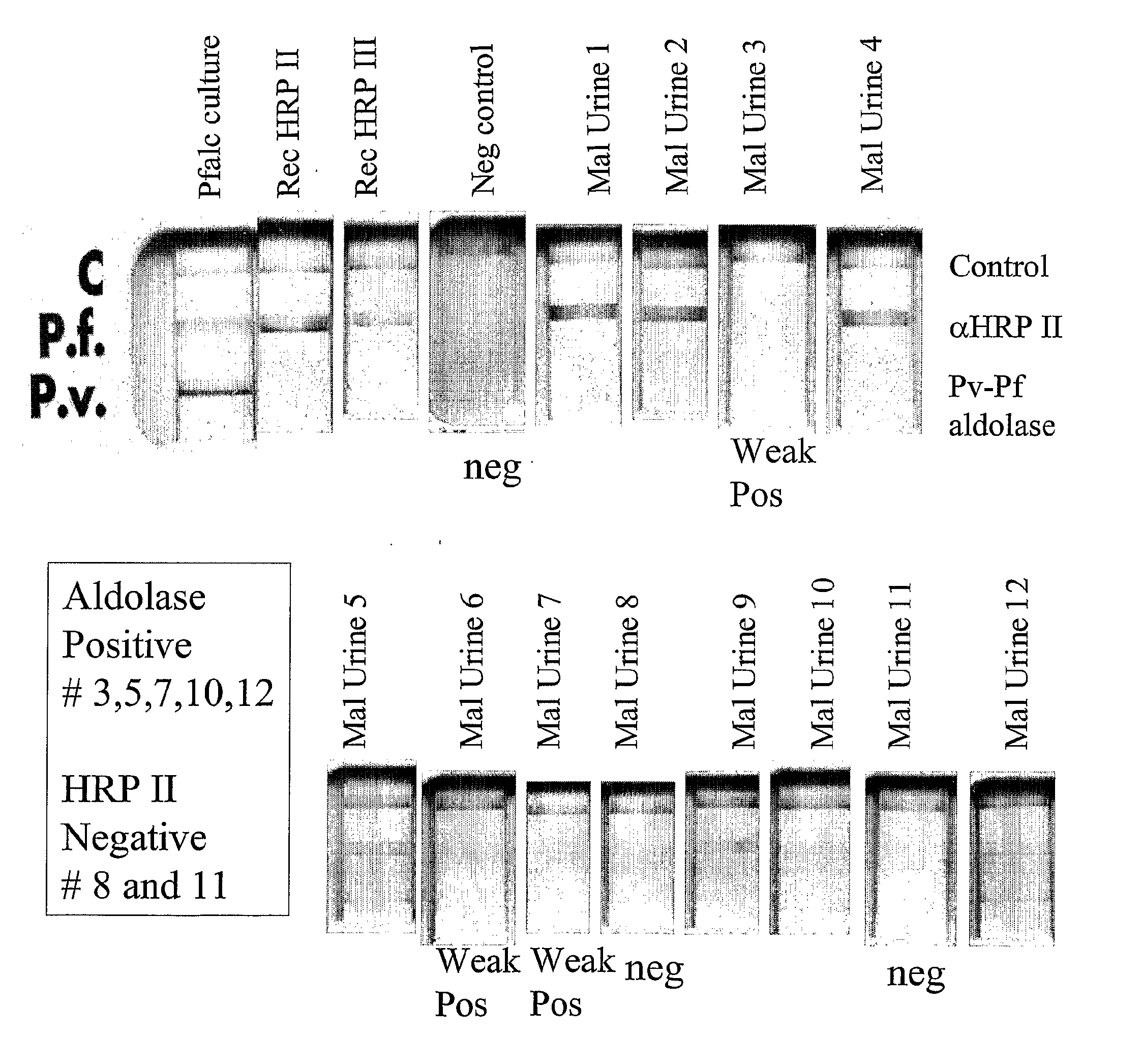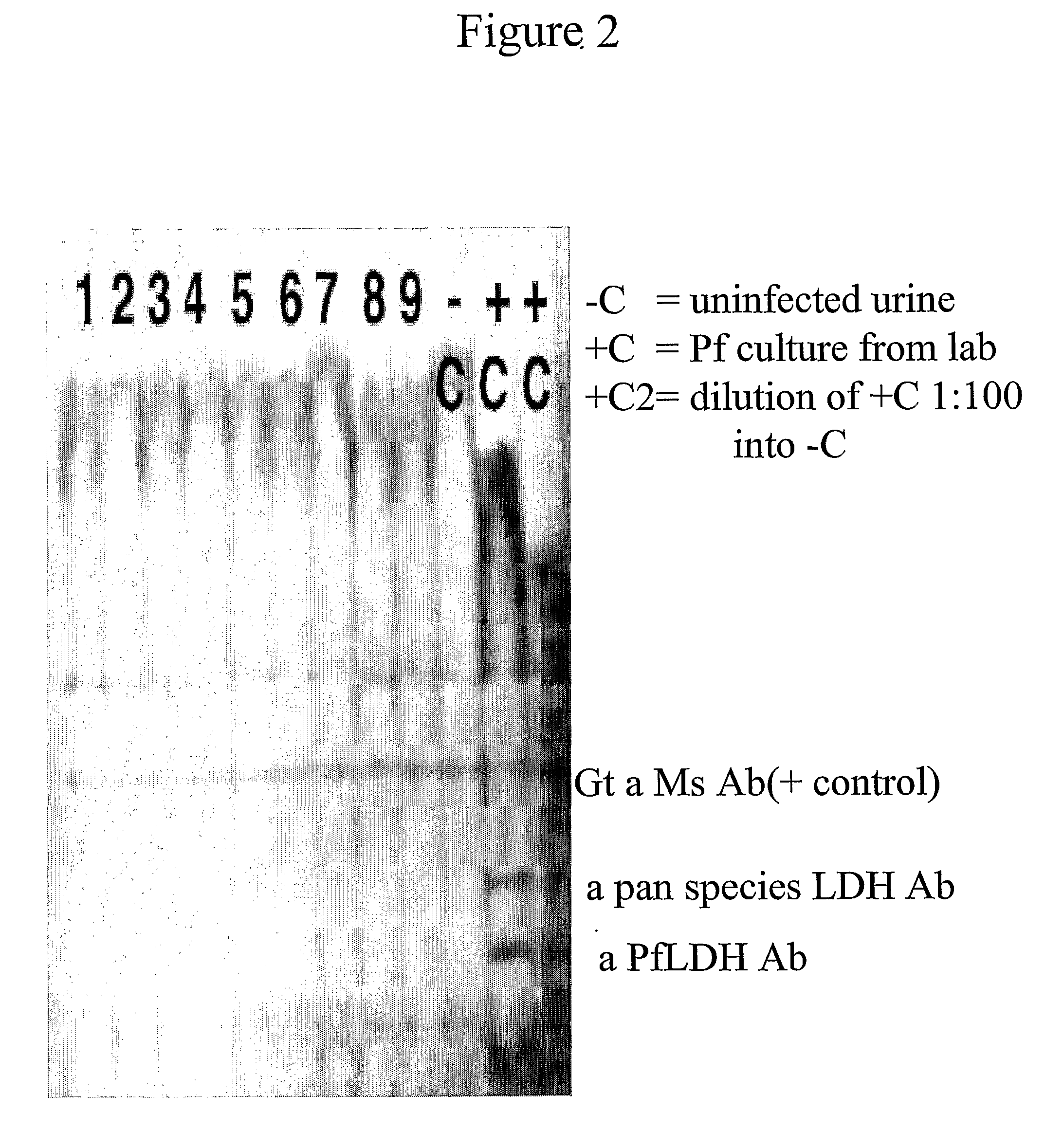Plasmodium Diagnostic Assay Device
a technology of diagnostic assay and plasmodium, which is applied in the field of analytes assay, can solve the problems of increasing the risk of transmission of diseases such as hepatitis b and hiv, malaria is predominant, and diagnostic capabilities are inadequa
- Summary
- Abstract
- Description
- Claims
- Application Information
AI Technical Summary
Benefits of technology
Problems solved by technology
Method used
Image
Examples
example 1
[0154]Of the analyzed, frozen archival from 2001, 12 urine samples with blood films positive for malaria from Zambia, it was found that 10 of 12 (83%) were positive for PfHRP II and / or III by the blood based Binax malaria Pf / Pv NOW®ICT. It was also found that 4 of 12 positive for the pan-species aldolase antigen by the blood Binax malaria test in FIG. 1. A commercial test for whole blood detection of parasite lactate dehydrogenase, found that none of the urines were positive for this protein in FIG. 2. The antibody in this commercial test kit may recognize only native protein and not be optimal for urine detection.
[0155]A panel of monoclonal antibodies to the antigens detected in the urine were made to verify results outside setting of commercial kits made for blood. Three hybridoma clones were identified, two to HRP II and III and one to a panspecies aldolase. The antibodies detect P. falciparum HRP II and III in FIGS. 3-6 and also the pan Plasmodium species aldolase in FIG. 7.
[015...
example 2
[0158]A specific urine designed malaria test (version number 1) was made to detect P. falciparum protein HRP II and III and aldolase.
[0159]The novel malaria urine tests described herein detects 40 picograms of HRP II in 200 microliters of urine in FIG. 10. Humans filter 180 liters of plasma into kidneys each day which is concentrated into˜liter of urine. Most is resorbed or degraded in kidney lysosomes. Malaria parasitemia=10-100 million infected erythrocytes per ml of blood. A million parasites make about a nanogram of HRP II. A thousand parasites per microliter×5 liter blood volume=5×109 total parasites=5 micrograms of HRP II; 40 parasites per microliter=200 million total parasites=200 nanograms HRP II. Two hundred (200) nanograms per liter is 200 picograms per ml or 20 picograms per 100 microliters. Therefore, the theoretical limit of detection is about 40 parasites per microliter.
[0160]ELISAs for HRP II detects about a nanogram of HRP II per 100 microliters. Western blots detect...
example 3
[0162]Urine malaria antigen detection was performed on 17 symptomatic children and 23 asymptomatic children (1 adult) in a field study. The symptomatic children presented ill to clinic or hospital. The asymptomatic patients were identified on an active community screen where healthy individuals had blood film read and urine was collected the next day. These individuals despite P. falciparum parasites in blood had no symptoms. The immunochromatographic test strip was placed in 200 microliters of urine and results read in 10 minutes with no other manipulations. The first ever positive urine malaria test is shown in FIG. 12. The urine malaria antigen detection was positive in 16 of 17 symptomatic children with confirmed blood film parasitemias, while only 2 of 23 asymptomatic children identified on an active community surveillance screen with confirmed blood films were positive by urine antigen detection as seen in Table 2 and FIG. 13.
TABLE 2Malaria urine testMultistix urine analysis r...
PUM
| Property | Measurement | Unit |
|---|---|---|
| pH | aaaaa | aaaaa |
| pore size | aaaaa | aaaaa |
| pore size | aaaaa | aaaaa |
Abstract
Description
Claims
Application Information
 Login to View More
Login to View More - R&D
- Intellectual Property
- Life Sciences
- Materials
- Tech Scout
- Unparalleled Data Quality
- Higher Quality Content
- 60% Fewer Hallucinations
Browse by: Latest US Patents, China's latest patents, Technical Efficacy Thesaurus, Application Domain, Technology Topic, Popular Technical Reports.
© 2025 PatSnap. All rights reserved.Legal|Privacy policy|Modern Slavery Act Transparency Statement|Sitemap|About US| Contact US: help@patsnap.com



